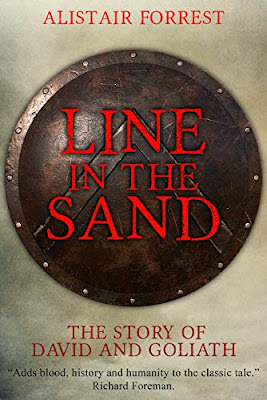1000 BC. His mother is reviled as a whore and his half-brothers despise him. The best Dhavit of Beth Lechem can do is escape. But just as life couldn’t get much lower for the youth they call Leper, he is recruited as a spy. His mission – to find out about the superior weapons and invasion plans of the warlike Philistines. When he is betrayed, Dhavit is thrown into an arena with two other misfortunates to fight a pair seemingly invincible warriors. Only speed and quick wits can save him. Dhavit believes he is chosen by the gods and finds himself revered in the Philistine court, whose rulers want to declare war on his people. At the head of the Philistine forces is the famed Golyat, a man bred for war and destruction. A vicious conflict for supremacy is sure to follow.
Capturing a Sense of Place, Part Two: David & Goliath
Alistair Forrest draws on an upbringing in the Middle East and a love of ancient history to explore fact and fiction surrounding a famous Bible story.
I’m an author of fiction, not a historian. So I don’t worry too much that some boffins and maybe religious folk might find my account of the David & Goliath story, Line in the Sand, a little annoying.
Instead, I hope lovers of historical fiction will accept that I have filled in some gaps that the ancient scribes left in their telling. This is how it might have been before the religious scribes got their hands on the tale.
I count myself lucky to have spent my childhood and early teens in three Middle Eastern countries and subsequently to have travelled widely as a journalist, always delving into the history that made each place what it is today. I’ve always had a burning passion to write historical fiction, in this instance fuelled by two years studying theology straddled by my early years as a newspaper reporter.
We know there are inconsistencies and contradictions across the several Biblical books that report the story of King David, leaving many questions unanswered. So, following my journalist’s mantra, ‘Never let the facts get in the way of a good story’, I have drawn on my studies of the ancient Near East and Old Testament history – let’s call these ‘the facts’ – and unleashed my imagination and love of ‘a good yarn’.
In reality, there are very few facts. The only archaeological reference to King David would appear to be a reference to the House of David on a ninth century stela found at Tel Dan in northern Israel in 1993. Most of the Biblical texts were written down long after the events surrounding David’s rise to power, with the two books of Samuel the earliest account.
Fair game, then? I decided that this bullied young shepherd should become a spy, find himself betrayed in the Philistine city where giants lived, be tortured and face branding as a slave, fight a giant called Golyat (Goliath) in a gladiatorial arena, rescue a Philistine princess and ultimately escape to warn the Israelites of pending doom.
You might think you know what happens next. Dream on. I have tried to anchor the story in certain Biblical facts, such as the tensions between the agricultural kingdom of Judah and the five Philistine city states, and the settling of scores in single combat (and who wouldn’t nominate a nine-foot warrior as champion?).
Which brings us to Goliath, or more accurately, ‘Golyat’.
At the outset of writing Line in the Sand, I listened to a very convincing lecture by Professor Jeffrey R. Zorn of Cornell University, entitled Who Was Goliath? in which he suggests that the Philistine giant was an elite chariot warrior. Most modern depictions of Goliath are as a very large foot-soldier, but Zorn points out his armour and weapons as detailed in 1 Samuel 17: 4-7 would indicate an Aegean/Levantine chariot warrior who was probably transported to the ideal position in a battle to wreak the most havoc.
While researching for the book, I was in touch with Professor Aren Maier, director of the Tel es-Safi excavations that have uncovered so much about ancient Gath, whence the giant came, including an inscription thought to include his name or at least something similar.
David and Goliath by Caravaggio
Instead, I hope lovers of historical fiction will accept that I have filled in some gaps that the ancient scribes left in their telling. This is how it might have been before the religious scribes got their hands on the tale.
I count myself lucky to have spent my childhood and early teens in three Middle Eastern countries and subsequently to have travelled widely as a journalist, always delving into the history that made each place what it is today. I’ve always had a burning passion to write historical fiction, in this instance fuelled by two years studying theology straddled by my early years as a newspaper reporter.
We know there are inconsistencies and contradictions across the several Biblical books that report the story of King David, leaving many questions unanswered. So, following my journalist’s mantra, ‘Never let the facts get in the way of a good story’, I have drawn on my studies of the ancient Near East and Old Testament history – let’s call these ‘the facts’ – and unleashed my imagination and love of ‘a good yarn’.
In reality, there are very few facts. The only archaeological reference to King David would appear to be a reference to the House of David on a ninth century stela found at Tel Dan in northern Israel in 1993. Most of the Biblical texts were written down long after the events surrounding David’s rise to power, with the two books of Samuel the earliest account.
Fair game, then? I decided that this bullied young shepherd should become a spy, find himself betrayed in the Philistine city where giants lived, be tortured and face branding as a slave, fight a giant called Golyat (Goliath) in a gladiatorial arena, rescue a Philistine princess and ultimately escape to warn the Israelites of pending doom.
You might think you know what happens next. Dream on. I have tried to anchor the story in certain Biblical facts, such as the tensions between the agricultural kingdom of Judah and the five Philistine city states, and the settling of scores in single combat (and who wouldn’t nominate a nine-foot warrior as champion?).
Which brings us to Goliath, or more accurately, ‘Golyat’.
At the outset of writing Line in the Sand, I listened to a very convincing lecture by Professor Jeffrey R. Zorn of Cornell University, entitled Who Was Goliath? in which he suggests that the Philistine giant was an elite chariot warrior. Most modern depictions of Goliath are as a very large foot-soldier, but Zorn points out his armour and weapons as detailed in 1 Samuel 17: 4-7 would indicate an Aegean/Levantine chariot warrior who was probably transported to the ideal position in a battle to wreak the most havoc.
While researching for the book, I was in touch with Professor Aren Maier, director of the Tel es-Safi excavations that have uncovered so much about ancient Gath, whence the giant came, including an inscription thought to include his name or at least something similar.
Excavating Goliath’s Gath
Books that have helped me include the Bible of course, The King David Report by Stefan Heym; The Source by James A. Michener; David’s Secret Demons by Baruch Halpern, and various books published by Osprey about warfare in the ancient Middle East.
I have read many books about ancient Israel both on-line and in my studies, too numerous to mention, all influential in their way. But somehow I still feel as though I know nothing when compared with the likes of Maier, Zorn and Rohl. I hope these knowledgeable historians will forgive my diversion from ‘what is known’ to ‘what might have been’.
What next? Although currently focusing on post-Republic Roman themes at the behest of my publisher Sharpe Books, especially the upheaval following the assassination of Julius Caesar (Libertas, Nest of Vipers, Viper Pit), I hope one day to return to my formative years in the Middle East and extensive studies of ancient Mesopotamia, including the amazing stories waiting to be reimagined of Assyrians, Israelites, Phoenicians and Philistines.
I have read many books about ancient Israel both on-line and in my studies, too numerous to mention, all influential in their way. But somehow I still feel as though I know nothing when compared with the likes of Maier, Zorn and Rohl. I hope these knowledgeable historians will forgive my diversion from ‘what is known’ to ‘what might have been’.
What next? Although currently focusing on post-Republic Roman themes at the behest of my publisher Sharpe Books, especially the upheaval following the assassination of Julius Caesar (Libertas, Nest of Vipers, Viper Pit), I hope one day to return to my formative years in the Middle East and extensive studies of ancient Mesopotamia, including the amazing stories waiting to be reimagined of Assyrians, Israelites, Phoenicians and Philistines.
And while there’s ink my pen, I must surely make the most of the archaeological dig just a few yards from my home in Alderney (Channel Islands) where archaeologists Jason Monaghan and Phil de Jersey have uncovered well-preserved remains of Roman and Iron Age settlements. The historian Dan Snow is keenly interested in the site. But that’s yet another story that must wait until the pandemic allows digging to resume…
An Iron Age skeleton is discovered beneath a Roman floor at Longis, Alderney. Photo: David Nash
# # #
About the Author
Alistair Forrest is a journalist, editor and author of historical fiction. He has worked for several UK newspapers, edited magazines in the travel, photographic and natural products sectors, and owned a PR company. He is author of Libertas and the Agents of Rome series, Nest of Vipers and Viper Pit. A third in this series is due out in summer 2021. He lives in the Channel Islands with his wife Lynda. They have five children, two Maremma dogs and a Spanish cat, Achilles. His books are published by Sharpe Books of London. Alistair loves to hear from readers. Contact him through his website https://alistairforrest.com and find Alistair on Twitter @alistairforrest







No comments:
Post a Comment
Thank you for commenting